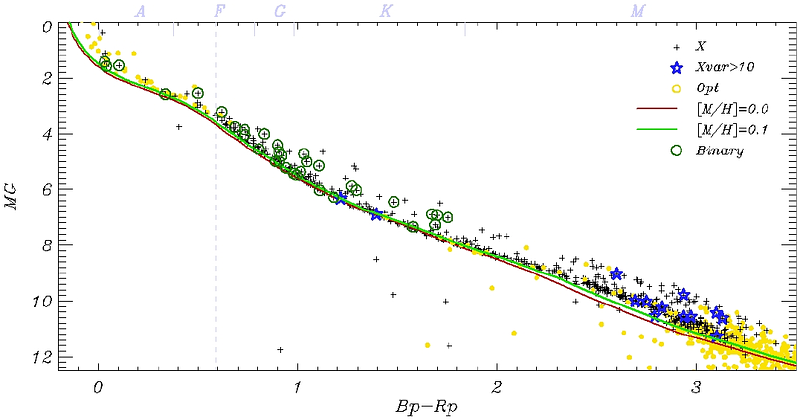850 SRG/eROSITA X-ray sources associated with Pleiades stars

850 SRG/eROSITA X-ray sources associated with Pleiades stars
I. M. Khamitov, I. F. Bikmaev, M. R. Gilfanov, R. A. Sunyaev, P. S. Medvedev
AbstractUsing data from the SRG/eROSITA all-sky X-ray survey and the GAIA-based catalog of 2,209 members of the Pleiades open star cluster, we found 850 X-ray sources associated with the cluster stars. Over 650 of them were detected in X-rays for the first time. At the distance of the Pleiades, the nominal sensitivity of eROSITA corresponds to a luminosity of $L_X \sim 1.6 \cdot 10^{28}$ erg/s in the 0.3-2.3 keV band. The eROSITA sources associated with Pleiades stars have a total luminosity of $L_{X,tot} \sim 1.3 \cdot 10^{32}$ erg/s , a million times greater than the X-ray luminosity of the quiet Sun. Strong X-ray variability, more than 10 times, was recorded for 27 sources. Most of them are known as eruptive optical variables of the dM class. The value of $R_X=log(L_X/L_{bol})$ increases with decreasing effective temperature of the star from $R_X\approx -5$ to $R_X\approx -2$. The distribution of stars over $R_X$ is bimodal, with the left peak at $R_X\sim-4.3$ being formed by stars of FGK classes, and the right peak at $R_X\sim-3.1$ being mainly populated by M-stars. The relation between $R_X$ and the Rossby number $Ro$ depends on the spectral class. For K- and M- stars, at low Rossby numbers $R_X\sim -3$ and depends weakly on $Ro$. At $Ro \gt 0.25$, a rapid drop in $R_X$ is observed for K stars, while in our sample there are no M stars with large Rossby number. Most of F- and G- stars appear to have smaller $R_X\sim -4.5$, however, our sample size is insufficient for a more detailed characterization of their $R_X-Ro$ dependence.